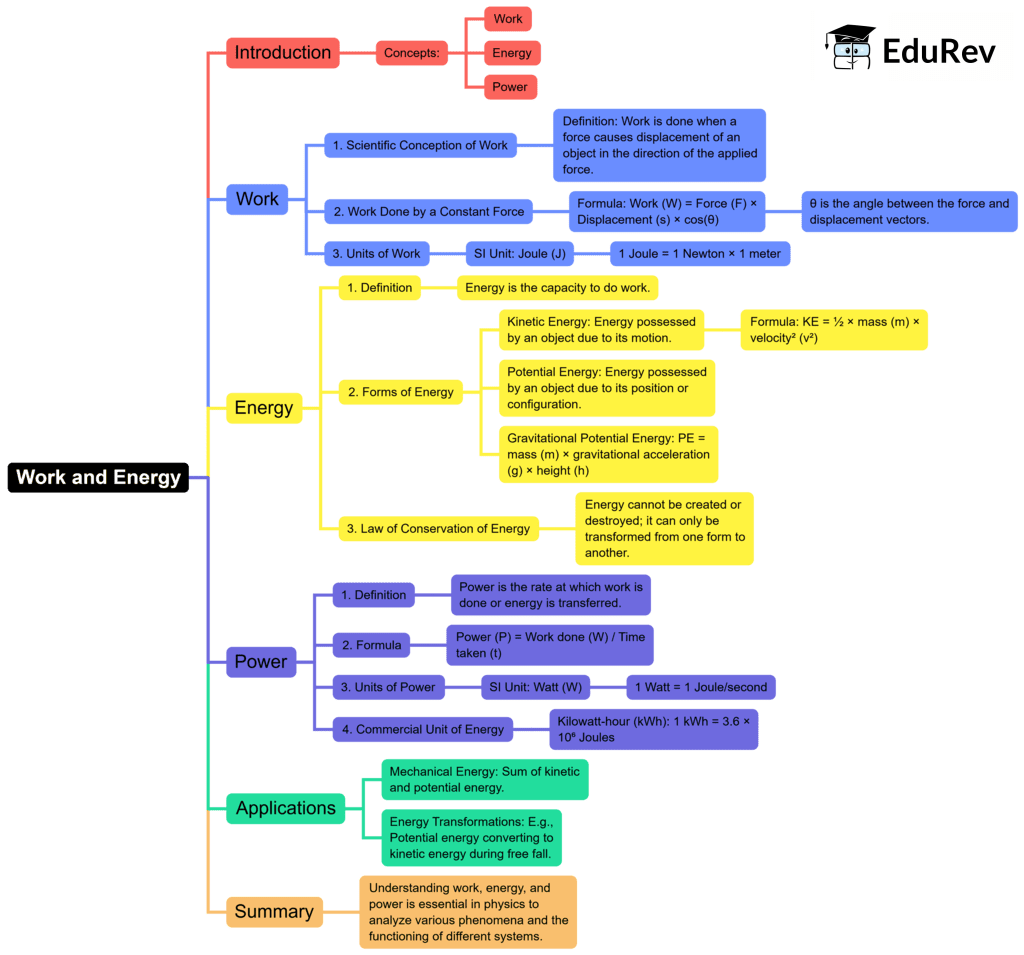Class 9 Exam > Class 9 Notes > Science Class 9 > Mind Map: Work and Energy
Mind Map: Work and Energy | Science Class 9 PDF Download

The document Mind Map: Work and Energy | Science Class 9 is a part of the Class 9 Course Science Class 9.
All you need of Class 9 at this link: Class 9
|
84 videos|478 docs|59 tests
|
FAQs on Mind Map: Work and Energy - Science Class 9
| 1. What is the definition of work in physics, and how is it calculated? |  |
Ans. In physics, work is defined as the transfer of energy that occurs when a force is applied to an object and the object moves in the direction of the force. It is calculated using the formula: Work (W) = Force (F) × Distance (d) × cos(θ), where θ is the angle between the force and the direction of motion. The unit of work is the Joule (J).
| 2. How is energy defined in the context of physics, and what are its different forms? |  |
Ans. Energy in physics is defined as the capacity to do work. It exists in various forms, including kinetic energy (energy of motion), potential energy (stored energy based on position), thermal energy (energy related to temperature), chemical energy (stored in chemical bonds), and electrical energy (energy due to electric charges). Each form can be converted into others, following the law of conservation of energy.
| 3. What is the relationship between work and energy? |  |
Ans. The relationship between work and energy is defined by the work-energy principle, which states that the work done on an object is equal to the change in its kinetic energy. This means that if work is done on an object, it will gain energy and vice versa. Mathematically, this can be expressed as: W = ΔKE, where ΔKE is the change in kinetic energy.
| 4. Can you explain the concept of mechanical energy and its components? |  |
Ans. Mechanical energy is the sum of potential energy and kinetic energy in a system. It is the energy associated with the motion and position of an object. The components of mechanical energy are:
1. Kinetic Energy (KE) = (1/2)mv², where m is mass and v is velocity.
2. Potential Energy (PE) = mgh, where m is mass, g is the acceleration due to gravity, and h is the height above a reference point. Mechanical energy is conserved in the absence of non-conservative forces like friction.
| 5. What are some practical applications of the concepts of work and energy in everyday life? |  |
Ans. The concepts of work and energy are applied in various everyday situations, such as:
1. Engine efficiency: Understanding how much work an engine can produce from fuel energy helps improve vehicle performance.
2. Electrical appliances: Calculating energy consumption of devices helps in managing electricity bills.
3. Sports: Athletes apply principles of work and energy to enhance performance, such as maximizing kinetic energy during a jump.
4. Engineering: Design of machines and structures often involves analyzing work and energy to ensure safety and efficiency.
Related Searches





















